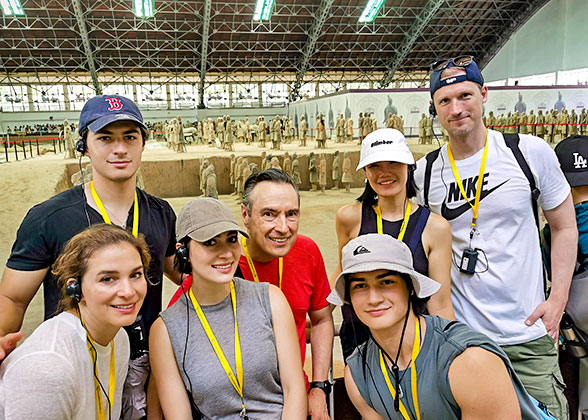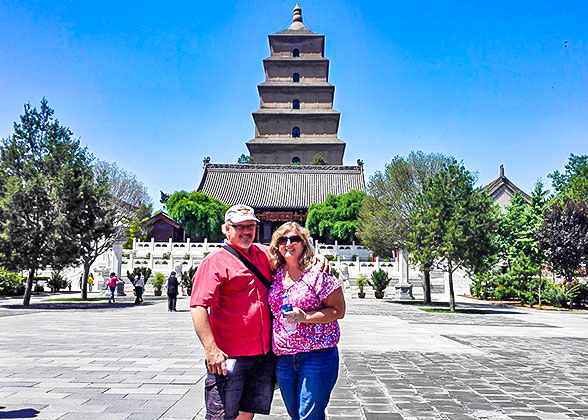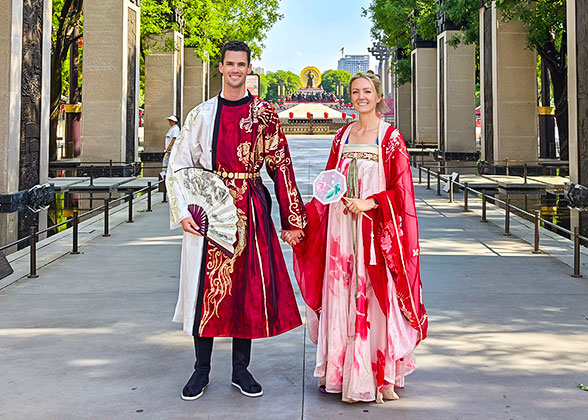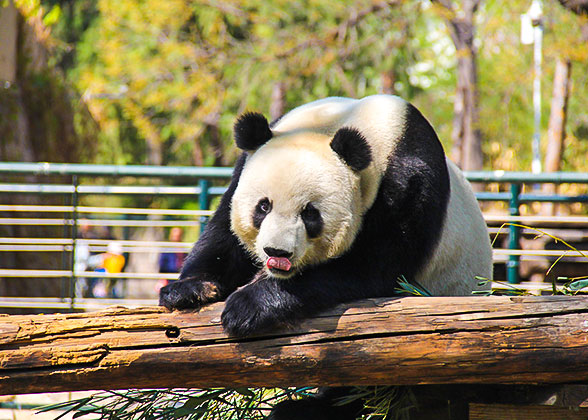On September 8, 2024, to commemorate the 50th anniversary of the archaeological discovery and excavation of the
Terracotta Army, the Emperor Qin Shi Huang's Site Museum opened a special permanent exhibit, "Archaeological Discoveries at the Mausoleum Complex of China's First Emperor." Situated on the second floor of the exhibition hall next to the
Terracotta Warriors Pit 2, the exhibit features 230 carefully chosen archaeological treasures, including important cultural relics from the outer eastern gate site and imperial mausoleum structures, many of which are being shown for the first time. It provides a comprehensive look at the major archaeological discoveries of the
Qin Shi Huang Mausoleum over the past five decades.
Divided into eight thematic units, this exhibition systematically explores the overall layout, cultural importance, and key aspects of
Qin Dynasty (221 - 207 BC) society, such as economy, military, art, entertainment, and social customs, using cultural relics displays combined with digital technology.
 Read more about Discovery of Terracotta Army in 1974
Read more about Discovery of Terracotta Army in 1974 Must-see Cultural Relics
Unearthed from Pit K9901 of the Qin Shi Huang Mausoleum, this tripod stands 61 cm (24 in.) tall, weighs 212 kg (467 lbs.), and has an outer diameter of 71 cm (28 in.). The body of the tripod is decorated with intricate and exquisite patterns, with handles attached on either side of the rim and three legs supporting the base. As the largest bronze tripod ever discovered at the mausoleum, its dignified and majestic appearance has earned it the title of "The First Tripod of the Qin Shi Huang Mausoleum".
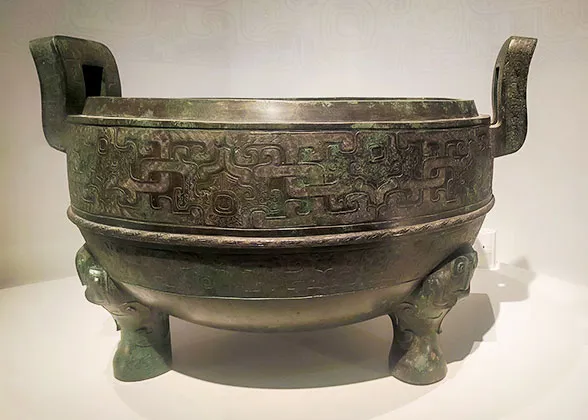 | | Bronze Tripod Unearthed from Pit K9901 | | 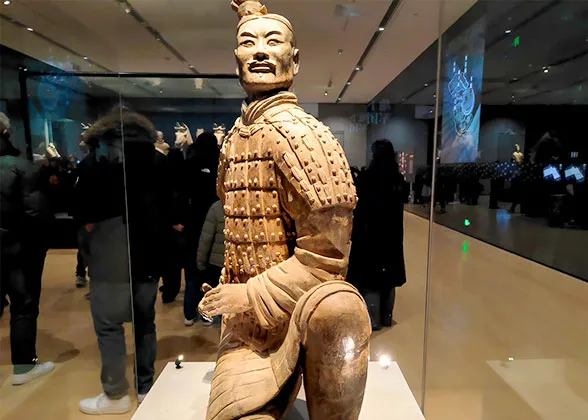 | | Well-preserved Kneeling Archer | |
2. Kneeling Archer
Excavated from the Terracotta Warriors Pit 2, this is one of the best-preserved terracotta warriors. With his hair meticulously tied in a bun and dressed in detailed armor, this warrior wears square-toed shoes with stitches being visible on the soles. His focused gaze forward vividly embodies the formidable presence of a Qin Dynasty crossbowman.
Unearthed from the subordinate tomb QLCM1 on the western side of the mausoleum, this is the earliest known golden camel found in China. Crafted from high-purity gold, it measures 5.4 cm (2.1 in.) tall and weighs 86 grams (3 ounces). Depicting a typical bactrian camel, it features a slightly raised head, turquoise-inlaid eyes, bent legs, and finely textured fur.
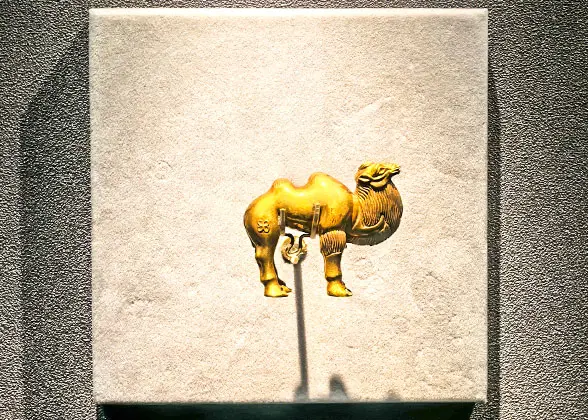 | | Golden Camel in Qin Shi Huang Mausoleum | | 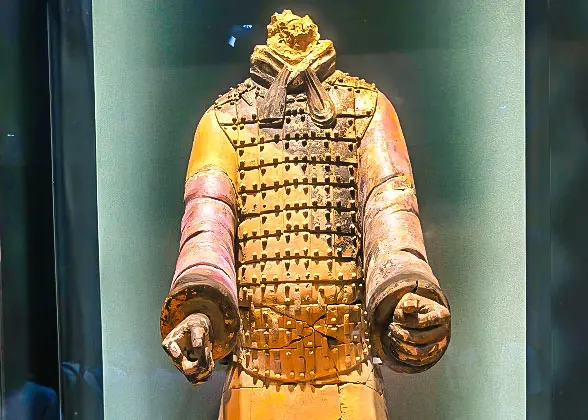 | | Terracotta Warrior with Purple Sleeves | |
4. Purple-sleeves Warrior
Making its first public display, the warrior is notable for its distinctive purple sleeves. The purple pigment is created by blending multiple natural minerals and firing at specific temperatures. This color cannot be perfectly replicated even with modern precise temperature control equipment, which attests to the Qin Dynasty’s unparalleled mastery in pigment craftsmanship.
Discovered in the bronze waterfowl pit, this lifelike crane retains traces of white pigment made from bone powder. Captured in the moment of lifting food from the water with its sharp beak, it represents a vivid avian life in the imperial gardens of the Qin Dynasty.
 | | Vivid Bronze Crane | | 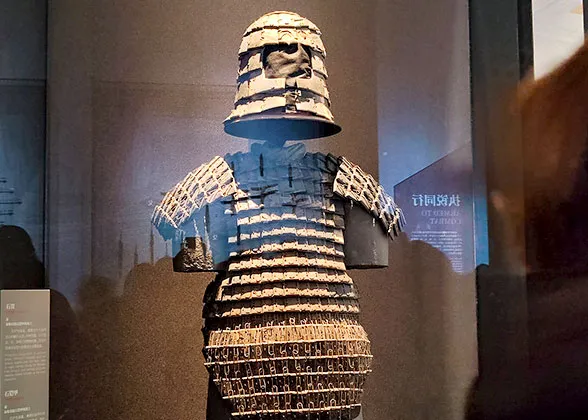 | | Stone Armor and Helmet | |
6. Stone Armor and Helmet
Excavated from Pit K9801, this stone armor consists of approximately 600 thin slate pieces linked by bronze wires, each piece only a few millimeters thick. Weighing around 18 kg (40 lbs.), experts believe it was likely ceremonial or funerary rather than practical combat gear. Meanwhile, the discovery of an accompanying stone helmet showcases the diversity of the Qin dynasty's armaments.
Eight Units of the Archaeological Discoveries Exhibition
Unit 1: China's First Emperor Qin Shi Huang
This unit takes the life of Qin Shi Huang as the main line, showcasing the rise of the Qin Dynasty and its historic unification of the six states. Through early pottery and other rare cultural relics, it vividly recreates the emergence of China's first centralized dynasty, marking a grand opening for the exhibition.
Unit 2: Construction of the Mausoleum
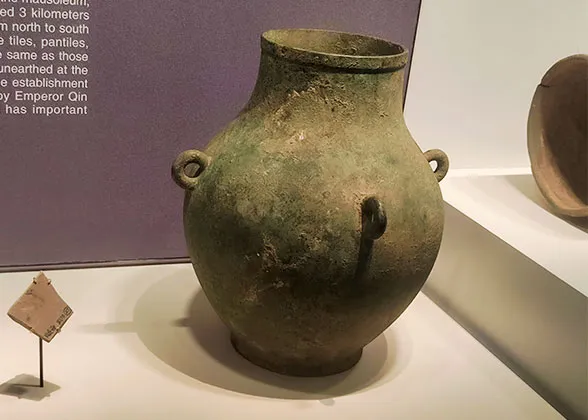 |
| Lishan Garden Bronze Bell |
This unit displays a collection of key cultural relics of the Qin Shi Huang Mausoleum. The Lishan Garden Bronze Bell is the first physical evidence that proves the mausoleum's original name and construction history, while the elaborate stone armors and helmets show imperial power, as such exquisite and high-quality military equipment was used for the imperial mausoleum. Together, these items reflect the two main construction principles: "a mausoleum should be like a capital city" and "embodying the emperor's supreme authority".
Unit 3: Palaces and Officials
In this unit, exquisite architectural components from the imperial palaces, such as ornate tiles and carved stones, show the grand palace architecture, while inscribed bronze tablets provide information about official affairs and central administrative offices. These items help visitors understand the layout and functions of ancient institutions.
 |
| Different Eaves Tiles |
Unit 4: Underground Army
As the exhibition's centerpiece, this section features a vast array of Terracotta Warriors and Horses, along with weapons from the Qin Dynasty. Through these cultural relics, we can gain an appreciation of the craftsmanship, artistic style, and military equipment of the Qin army.
Rare terracotta generals with clear, exquisite patterns on their clothes are displayed there. Some terracotta warriors are preserved with conspicuous colors, such as pink lips that resemble lipstick, while a headless warrior draws our attention with its striking purple sleeves. In addition, the ancient bronze weapons on show are still glittering, showing ancient China's incredible rust-prevention techniques.
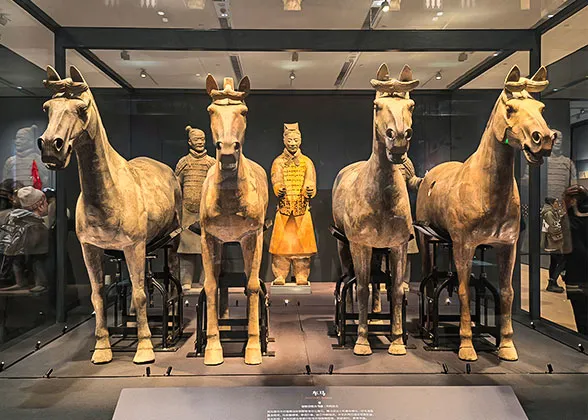 | | Terracotta Horses | | 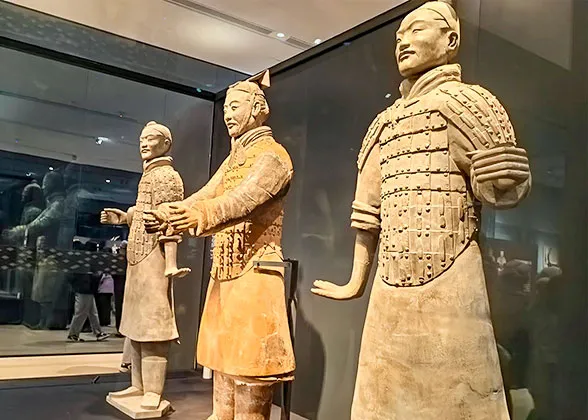 | | Different Kinds of Terracotta Warriors | |

Read more about:
Top 10 Weapons of Terracotta ArmyHow the Terracotta Warriors were Made? Unit 5: Rare Birds and Animals
This unit recreates an underground imperial garden of the Qin dynasty, featuring rare birds such as swan geese, swans, and cranes, showcasing the extravagance of royal life.
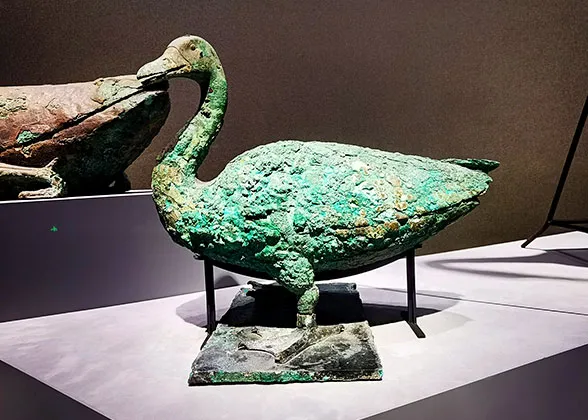 | | Lifelike Bronze Swan | | 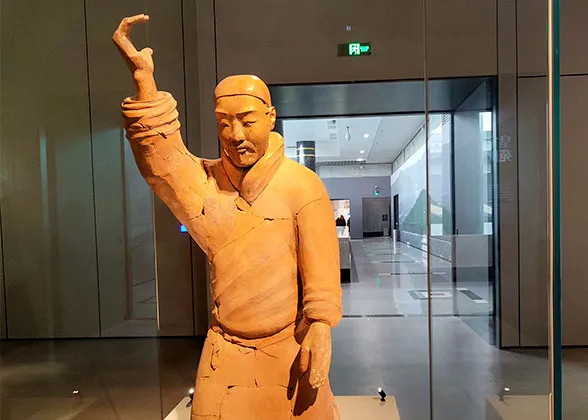 | | Terracotta Figure for Domesticating Bronze Birds | |
Unit 6: Entertainment in the Court
This unit displays pottery warriors excavated from burial pits in the southeast of the mausoleum, between its inner and outer walls.
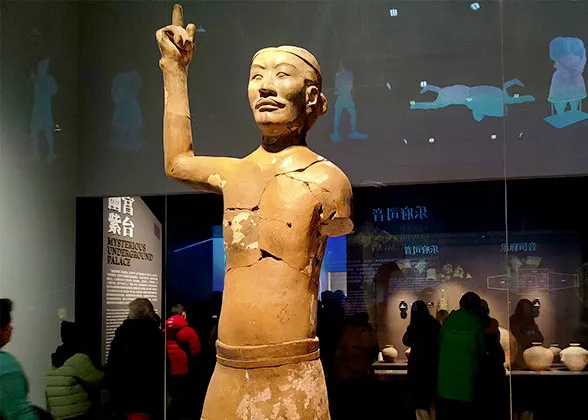 |
| Acrobatic Performer |
These warriors, known as "acrobatic performers," depict various poses: standing upright, rolling up sleeves using two hands, raising one arm while the other rests over the waist, or kneeling. They represent ancient entertainment scenes, revealing that the luxurious court life with colorful entertainment activities existed over 2,000 years ago.
Unit 7: Serving as He was Alive
This unit features a display of cultural relics that reflect the "subordinate burial" and "companion burial" practices of the Qin Shi Huang Mausoleum. The displayed replicas of burial items from the Qin Shi Huang Mausoleum, like pottery, jewelry, and daily-use objects, show the "treating the dead as if they were alive" practice. In addition, the tomb layout model also demonstrates the strict hierarchical burial rites with subordinate tombs close to the emperor’s main tomb.
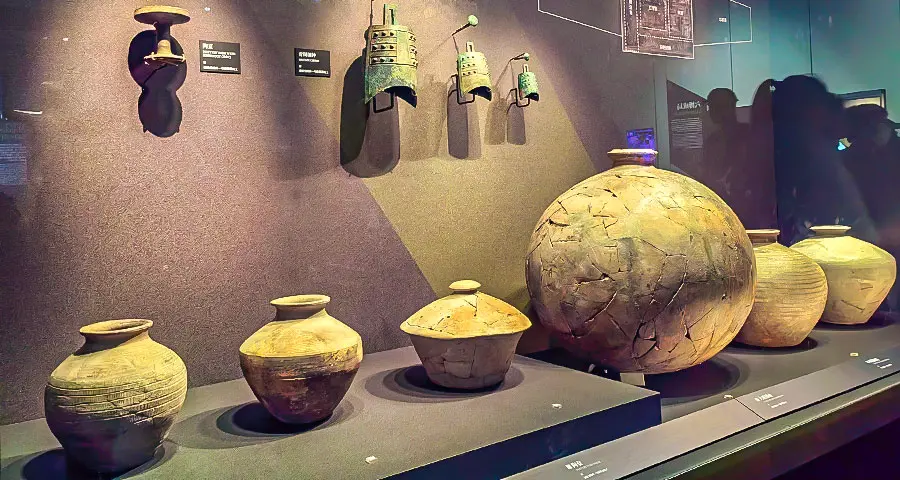 |
| Unearthed Wares around Qin Shi Huang Mausoleum |
Unit 8: Mysterious Underground Palace
The underground palace of Qin Shi Huang Mausoleum remains unexplored due to unimaginable excavation challenges. Using modern technological means, this unit presents to visitors the mysterious and magnificent underground palace revealed by historical documents and actual archaeological discoveries.

Further Reading:
- Last updated on Aug. 22, 2025 by Doris Xue -
 Read more about Discovery of Terracotta Army in 1974
Read more about Discovery of Terracotta Army in 1974 Read more about:
Read more about: Further Reading:
Further Reading:














